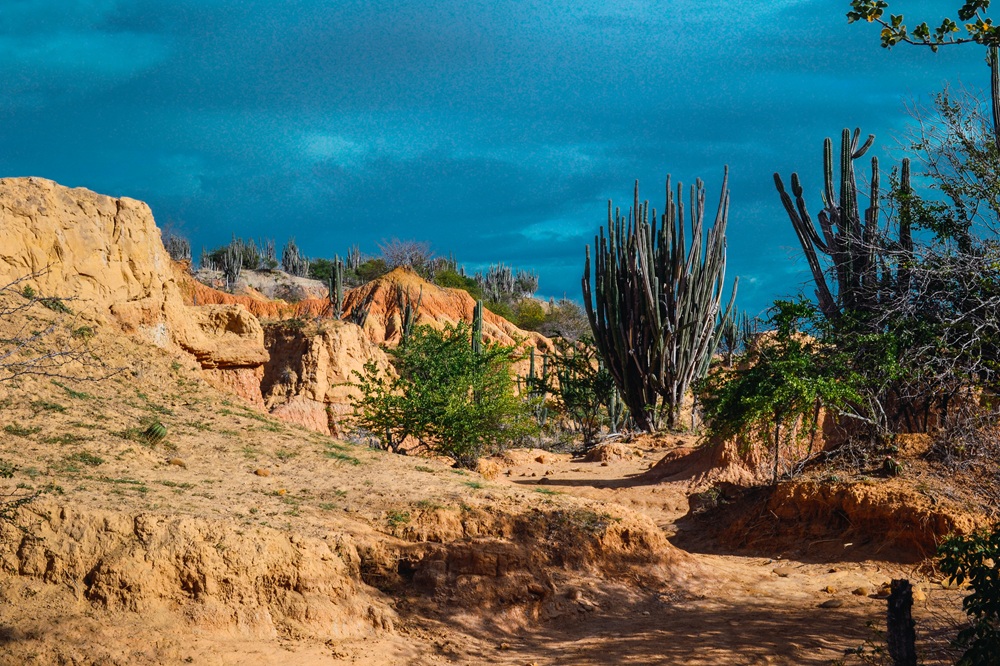La Guajira
At the northern tip of South America, Colombia’s La Guajira peninsula is a starkly beautiful world of ochre desert, wind-sculpted dunes, jade-green bays, and star-bright skies. It’s home to the Wayuu people—renowned for their weaving traditions—and to wild coastal landmarks like Cabo de la Vela and Punta Gallinas, the continent’s northernmost point.
Highlights
- Cabo de la Vela: Golden cliffs, kitesurf winds, sunsets from Pilón de Azúcar, and calm, shallow bays.
- Punta Gallinas: Remote lighthouse, vast dunes dropping to turquoise water, and lonely beaches like Bahía Hondita.
- Dunas de Taroa: Iconic sand dunes that slide straight into the Caribbean—run down for a salt-sprayed splash.
- Manaure Salt Flats: Kaleidoscope of salt ponds and wind-rippled pans—great for photography in morning light.
- Flamingos Sanctuary (Camaronera/Riohacha area): Seasonal flocks feeding in coastal lagoons (best with a local boat guide).
- Wayuu Culture: Learn about chinchorros (hammocks), mochilas (woven bags), and matrilineal customs; support community-run hospedajes.
When to Go
Dec–Apr is typically drier and windier (prime for kitesurfing and clear skies). May–Nov can bring scattered showers, calmer winds, and greener patches in the desert. Temperatures are warm year-round; nights can be breezy.
Getting There & Around
- Bases: Riohacha is the usual jump-off point for tours, supplies, and ATMs.
- Transport: Distances are long over unpaved roads; a 4x4 with local driver/guide is strongly recommended.
- Routes: Common circuits: Riohacha → Manaure → Cabo de la Vela → Punta Gallinas → Riohacha.
- Connectivity: Signal is limited; download maps and notify contacts before departure.
Where to Sleep & Eat
Stay at rancherías Wayuu (community lodges) in simple rooms or chinchorro hammocks under thatched roofs. Expect fresh fish, rice, plantains, and arepas; bring snacks for long drives. Electricity can be limited—charge during generator hours.
What to Bring
- Sun armor: Wide-brim hat, UV shirt, sunglasses, high-SPF sunscreen.
- Wind & sand prep: Buff/scarf, lightweight jacket for evenings, zip pouches for electronics.
- Hydration & cash: Large water bottle, electrolytes, and cash for community fees and crafts.
- Overnight basics: Towel, headlamp, power bank, biodegradable toiletries.
Respect & Etiquette
- Ask before photos: Especially of people and private spaces; offer thanks or a small tip when appropriate.
- Buy local: Support Wayuu artisans—authentic mochilas take weeks to weave.
- Leave no trace: Pack out trash; dunes and mangroves are fragile.
- Community norms: Guides help navigate road checkpoints and customs—follow their lead.
Photography Tips
- Golden hours: Sunrise/sunset for dunes and cliffs; mid-morning for mirror-like salt flats.
- Protect gear: Keep cameras in sealed bags between shots; use a rocket blower for sand.
- Scale: Place a person or 4x4 against dunes/cliffs to show immensity.
La Guajira rewards those who love raw horizons and cultural encounters—where the desert meets the Caribbean and Wayuu heritage shapes every journey.


